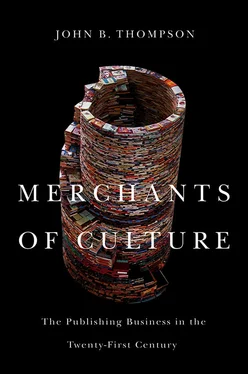A second consequence of the rise of the retail chains was a gradual shift in the ways that books were stocked and sold. This shift began with the mall stores in the late 1960s and early 1970s, and it went hand in hand with the application to bookselling of the methods of selling and stock management that were being used in other retail sectors. Situated in the high-traffic retail space of the shopping mall, B. Dalton and Waldenbooks had to organize their stores in ways that would maximize stock turnover. Table displays and dump bins were used to stimulate impulse buying and multiple purchases. Computerized systems of stock management were introduced to monitor stock levels and stock turn, so that fast-selling titles could be promptly reordered and stock that was not selling could be returned. These retail practices were incorporated into the operating principles of the new superstores that were opened in the 1990s. The sheer size of the superstores gave Barnes & Noble and Borders more leeway in terms of the range and depth of stock. They could stock more specialized books and more slow-moving backlist titles than the mall stores, with their much smaller floor area, could afford to keep on the shelves, and this became an important part of their value proposition. Nevertheless, the superstores continued to place a great deal of emphasis on maximizing stock turnover in the highly visible space at the front of the store, where new books and bestsellers were stacked on tables and in dump bins and where publishers were charged for display space. As the national roll-out of the superstores began to grind to a halt around 2000 and the superstore chains began to look more carefully at the relations between investment in stock, overheads and revenues and became more concerned about cash flow, their book-buying decisions became more cautious and they became more proactive about returning slow-moving stock. The chains had succeeded in bringing bookstores into the shopping malls and city centres where Americans did the rest of their shopping, had made books more available than ever before and had turned book-buying into a consumer experience like any other. But the more books were treated like any other commodity and subjected to the same principles of retailing, the more the chains would be forced to focus on fast-selling titles by brand-name authors at the expense of those titles that would add depth and range to the store but that would have much slower stock turns.
This inevitable shift was largely the consequence of the cost of real estate. Maintaining large bookstores in the shopping malls and city centres where there is high consumer traffic, and therefore competition for retail space, is a very costly business, and it is difficult to cover these costs and generate profits in a low-margin activity like bookselling. The pressure to reduce your investment in slow-moving stock, to focus more attention on fast-moving bestsellers and to look for other ways of improving margin – such as charging publishers more for display space and stocking non-book goods like chocolate and stationery where margins are higher – is difficult to resist. Epstein puts the point well: ‘In bookselling as in any retail business, inventory and rent are a trade-off. The more you pay for one, the less you can spend on the other.’ 16 Hence the growing dominance of the retail book chains, from the mall stores to the superstore chains, tended over time to accentuate the importance within the industry of fast-selling frontlist titles by authors with a good track record and a degree of name recognition. The chains were more likely to stock these books in substantial quantities and more likely to display them in prominent front-of-store positions, thereby increasing their chances of selling well. Books by less well-known authors were not ignored – on the contrary, the central buyers in the chains were always eager to find new authors and new titles that might appeal to their customers. But decisions about which books to buy, in what quantities, how to promote and display them and how long to keep stock on the shelves were being taken in contexts that were shaped by the increasingly stringent financial demands of running large retail businesses in expensive real estate. These were contexts that tended, over time, to reduce the levels of tolerance for slow-moving stock.
The rise of the retail chains had a third consequence which has been less appreciated but which was enormously important for the evolution of the publishing industry: it created a new market for what could be described as the ‘mass-market hardback’. Much has been written about the paperback revolution started by Allen Lane in Britain, with his launch of the Penguin imprint in the 1930s, and by the rise of Pocket Books, Bantam, Dell, Fawcett, the New American Library and other paperback houses in the US in the period after the Second World War. From the 1940s on, the sales of mass-market paperbacks grew enormously; paperbacks were being sold in newsagents, drugstores, supermarkets, airports, bus terminals and railway stations as well as in more conventional bookstores. Mass-market paperback sales became the financial driving force of the industry, and the sale of paperback rights became a principal source of revenue for the hardcover houses. By the 1960s the industry itself had bifurcated into two separate businesses – hardcover publishing, on the one hand, and paperback publishing, on the other. ‘The perception was that the only similarity between the two is that we both published books,’ explained one senior executive who had entered the paperback side of the business in the late 1960s. ‘The hardcover side was snobby, literary, prestigious, tweedy – all the things you would expect in that era. And the paperback business was sort of second class – we got the books a year later, we got no credit for the words, we were all about marketing, packaging, distributing and selling books. So you had these two universes coexisting, neither respecting the other very much but one totally dependent on the other for product.’ While the paperback business depended on the hardcover business for product, the hardcover houses depended heavily on royalty income from paperback sales to run their businesses.
The rise of the mall-store chains in the late 1960s and 1970s stimulated the sales of paperbacks and strengthened further the position of the paperback houses, as the mall stores embraced the paperback and made it available in a bookstore environment that was much more inviting and less intimidating for consumers than the traditional bookstore. By the mid-1970s, some of those working in the paperback houses began to realize that their business model – which made them dependent on the hardcover houses even though they, the paperback houses, were generating the real volume sales – was not a terribly good one. There were even cases where the publisher at a paperback house who had came up with the idea for a book was obliged to find a hardcover house to publish the initial hardcover edition, so that they could then license the paperback edition from them. ‘It would be like me coming to you and saying “look, I don’t have any editors here, edit this book for me, publish it in hardcover, I’ll give you the book to do that and then I will pay you some portion of the success I have after you do that,”’ explained a publisher who had started his career as an editor at a paperback house. Some of the employees at the paperback houses – usually the younger ones who were less wedded to the traditional model and less worried about offending the hardcover houses who were their traditional source of product – saw the need to start publishing books on their own. So in the 1970s the paperback houses began to originate their own titles, initially publishing them as paperback originals and then, by the late 1970s, publishing their own hardcover books. Crucially, they applied to hardcover publishing some of the techniques they had developed in the world of mass-market paperback publishing, such as using more attractive packaging and extending distribution to non-traditional outlets, and they were able in this way to achieve hardcover sales that were unprecedented in volume. This was the origin of the ‘hardcover revolution’.
Читать дальше












